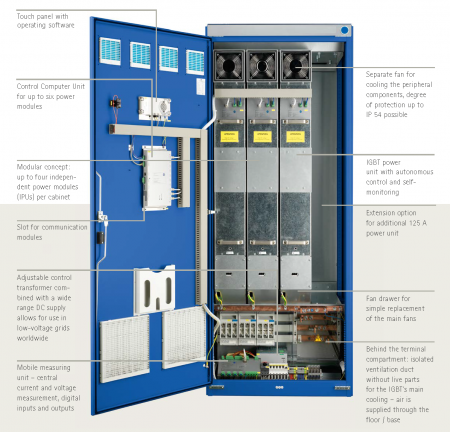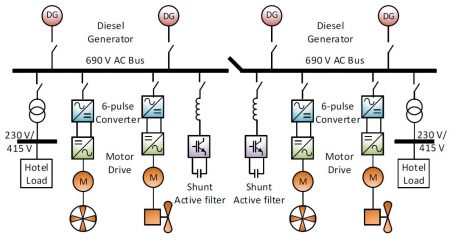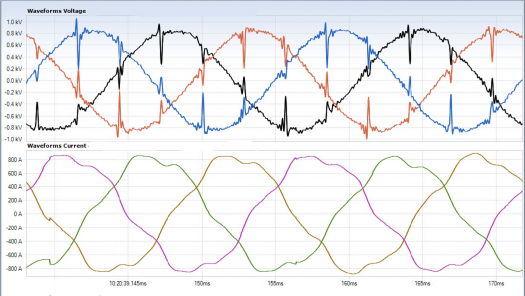
MOSAF Series of Active Filters
The MOSAF series of active filters is the number one choice for challenging marine harmonic and PQ compensation tasks where performance, reliability and safety are critical, for example, even beyond normal operating voltage levels and under challenging environmental ambient conditions:
- Operation up to 690 V and higher voltage levels at full power without derating
- Rated current can be extended in a modular manner from 125A to 2500A
- Harmonic compensation to 9kHz with optional module (up 51st as standard)
- Isolates susceptible and sensitive downstream equipment from background MV or MV voltage distortion
- Advanced 3-level architecture, high power density and compact design
- Low operating losses
- Extremely durable, long life film DC bus capacitors
- Overvoltage category III up to 1000 V
- Degree of protection up to IP20, IP21 and IP54 possible with optional external water cooling for complete encapsulation
- Dynamic compensation of reactive power, harmonics, and flicker, as well as load balancing in one unit
- MOSAF can provide harmonic compensation for both MV and LV applications
The central control and display element of MOSAF is via the door mounted touch panel and/or a LAN. It has a clear menu structure and can display data in both tables and diagrams. The benefits of the touch panel include:
- Simple parameterization of the filter function without additional measuring devices. Though a more complex power quality analyser can be provided based on client requirement.
- Explanations and status messages in plain text in a number of languages
- Intuitive operation and password protection
MOSAF can also be operated via the internet. Once incorporated into a company network or connected via a mobile phone network, it can be monitored or parameterized remotely using a browser.
Advanced 3-Level technology
The 3-level design of MOSAF is based on twelve IGBTs. Conventional 2-level active filters only comprise of six IGBTs. The three-level configuration reduces the voltage stressing on the power semiconductors by 50%, resulting in lower losses and permits the MOSAF to be used in systems with a higher rated voltage. The DC link voltage is also higher which permits higher peak currents to be generated lowering losses, essential for filtering harmonics with a high bandwidth.
Another benefit of the 3-level technology is the lower ripple of the output current compared with the 2-level architecture. The split DC link and the larger number of IGBTs results in an additional third inverter state at the output. This reduces the size of the carrier frequency and EMC filters. The difference between 2-level and advanced 3 level-architecture is shown below:
In the marine industry worldwide, many types of variable speed drives are utilised; indeed, their use is accelerating. From DC SCR drives to AC synchronous drives, cycloconverters, load commutated drives and PWM variable frequency drives used for main propulsion to cranes, compressors, fans and pumps and more, the benefits of variable speed drives are widely acknowledged. However, all have types of variable speed drives require some form of harmonic mitigation.
However, not only variable speed drives cause harmonic distortion of the voltage, although they are usually the main culprit. On cruise ships and other vessels, for example, multiple single-phase loads can cause problems. LED lighting emits supraharmonics up to 150kHz.
The application of MOSAF active filters reduce voltage distortion significantly over a wide range of harmonic frequencies. This enables compliance to the rules from marine classification societies such as Lloyds Register, ABS, DNVGL, BV and other classification societies and thus ensures the operational integrity, reliability and safety of the vessel.
Harmonic mitigation performance
Typical applications for MOSAF – Marine vessels
The majority of cruise ships have diesel electric propulsion. Historically, these vessels have had 24 pulse cyclo-converters or 24 pulse synchronous drives for main propulsion, but the trend is now on new builds, to utilise MV PWM (pulse width modulated) variable frequency drives (VFDs) with all the issues thereof.
In addition, most cruise lines have been retrofitting large numbers of PWM VFDs for pump and fan applications to save energy and generator fuel. This raises the localized THDu levels which are often compounded by background voltage distortion due to the main propulsion (see example below). MOSAF is the ideal candidate for the mitigation of the switchboards supplying the large number of VFDs.
Background THDu can be a serious problem on vessels with full electric propulsion
It is not unknown, irrespective of the class or the type of main propulsion drive system utilised, for the THDu to exceed the classification limits and to adversity affect LV equipment downstream. Excessive THDu can interfere with monitoring and protection systems and all other equipment including electric motors, especially fixed speed explosion motors where under certain circumstances, these motors may be potentially dangerous.
It should also be noted that the design, testing and certification of fixed speed explosion-proof motors, of all design concepts (i.e. flameproof, increased safety, pressurised and so called “non sparking), is usually based in pure sinusoidal supplies (0% THDu). Above 0% THDu, the motors are “operating the conditions envisaged when the motors were certified” (BASSFEA 1988). This does not necessarily mean that the motors are unsafe; however, they could be under certain conditions, but the third “approval” for the motors is no longer valid.
The photograph below is of a bearing surface from an LNG carrier fixed speed MV EExd motor which has 45MW of PWM electric propulsion. The life of the bearings regularly did not exceed 1500hrs below failure. These failures where due to common mode voltage and current, NOT excessive background THDu. However, excessive THDu can result in winding failure, excessive rotor temperatures, especially on double cage or deep bar machines. In the context of explosion motors, of all protective concepts, excessive level of rotor heating does give serious cause for concern regarding the motor temperature class, the integrity of bearings and the flameproof gaps in “flameproof” motors.
The serious issue of background THDu can be resolved with MOSAF using the voltage control feature.
MOSAF has three modes of control :
- Open loop (load sensing with the CTs on the side)
- Closed loop (source sensing with the CTs upstream of the filter connection)
- Voltage control (where CTs are not required since special control is activated)
Active filters, capable of voltage control, directly target the voltage instead of injecting a compensation current based in the CT signals. Hence voltage control enables “sensorless control” without CTs, often with better results.
For background voltage distortion mitigation, (i.e. the localised reduction of harmonic levels fed by medium voltage (MV) networks or transformers with high levels of THDu), MOSAF voltage control is a mandatory requirement. In addition, the voltage limiter function inbuilt within MOSAF enables autonomous output adaption for automatic harmonic standard compliance. Note, with MOSAF, the voltage control modes are selectable per frequency for optimised performance.
This vessel has two 12 pulse 4.25MW main propulsion VFDs. The primary of one 12-pulse phase shift transformer had an additional phase shift resulting in a quasi-24 pulse configuration with the bus-tie closed. The THDu at each primary exceeded the rules (<8% <THDu). The excessive THDu in this instance was due to switching harmonics; the THDi (harmonic current distortion) was relatively low.
The excessive THDu propagated through the transformers to the bridge, ships office and other loads, resulting in significant problems in the galley (440V), the ships office and the bridge, both of the latter were on 230V supplies. Two MOSAF ‘voltage control’ filters were employed to effectively “isolate” the high MV THDu from the low voltage (440V and 230V) supplies. The MOSAFs successfully reduced the THDu from >13.4/13.2% to 2.1/2.0% respectively.
Mitigation of Supraharmonics to 9kHz
Almost all active filters compensate for harmonics to the 50th order only. MOSAF, in conjunction with a specifically designed internal, high-pass, SHU module, can treat supraharmonics up to 9kHz (150th order at 60Hz fundamental or 180th order at 50Hz) as illustrated below.
This combination can compensate for AC, DC drives and active filter switching voltage harmonics, SCR line notching and LED lighting, for example up to 9kHz as illustrated below.
MOSAF general specification
Enclosure dimensions
Harmonic Solutions Marine has the knowledge and experience
MOSAF is available in compensation ratings from 125A to 2500A per connection in enclosures to IP20, IP21 and IP54. Water cooling is also an option. MOSAF applications covers all aspects of marine PQ including supraharmonics to 9kHz and the treatment of background harmonic voltage distortion.
When applied correctly, active filters are an important tool in the harmonic mitigation toolbox. However, no form of harmonic mitigation is perfect. The secret of success is recognising the pros and cons of all types of active and passive mitigation and being able to apply the most appropriate form of mitigation for any given application. The staff at Harmonic Solutions Marine have been involved in applying active and passive filters since 2003 to a large number of demanding marine and offshore applications.
A complete range of AC line reactors for use with VFDs and DC SCR drives are available to assist full compliance and optimum performance. For more information please click here.
If a visit to the vessel is required to carry out detailed measurements or PQ troubleshooting, we have fully trained PQ engineers available. To view our section on Marine PQ Services please click here.
Contact us with your application details and let us assist you.





















